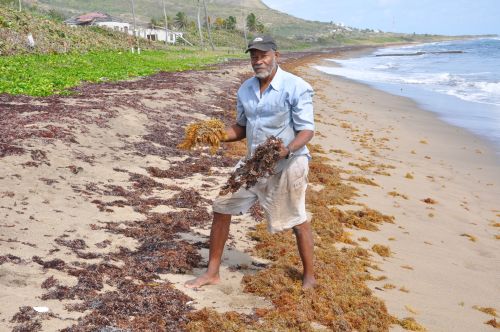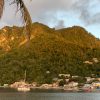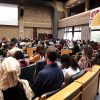Saturday, May 11, 2024
News and Views from the Global South
Kittitians See Ominous Signs of Climate Change

Dr. Barrington Brown holds freshly washed up Sargassum seaweed in one hand and older seaweed in the other. Credit: Desmond Brown/IPS
- It is mid-morning and the temperature has already soared to 80 degrees Fahrenheit.
But that does not prevent Dr. Kimberley Stewart and her group of about 50 volunteers from carrying out their monthly exercise to clean up Keys Beach, one of the main sea turtle nesting beaches on this tiny Caribbean island.
The United States native, who first came here in 2002 to attend the Ross University School of Veterinary Medicine, has been a long-time volunteer on sea turtle projects. She joined the university’s faculty after successfully completing her studies in 2006.
Dr. Stewart has teamed up with the Fisheries Department and the National Trust to establish the St. Kitts Sea Turtle Monitoring Network (SKSTMN).
Between March and July each year, approximately 40 to 65 female leatherback sea turtles come to Keys Beach to lay their eggs. Leatherbacks can travel as far as 19,000 kilometres between their nesting and foraging grounds.
Dr. Stewart told IPS she has been growing more and more concerned about losing nesting beaches here and believes climate change is a contributing factor.
“We have had some increased erosion over the past couple of years, that’s one of our main concerns and we are monitoring that very closely,” she said. “We do have GPS coordinates of all of our nests so that we can actually look back over the years and determine if we are losing beach.”
Dr. Stewart is also concerned that increased temperatures could result in the sea turtle population becoming skewed since the creature’s gender is determined by temperature.
“When the eggs are laid they are not male or female, the gender is determined by the incubation temperature, so high incubation temperatures produce more females and lower incubation temperatures produce males.
“So that is something with climate change and increasing temperatures that we could potentially see as an issue with turtles,” she explained.
The twin-island federation, like many other islands in the Caribbean and the Asia-Pacific region, has no streams, rivers or large freshwater ponds. For this reason no one bothered to introduce aquaculture to the country, which has a population of about 50,000 and an economy depending mainly on tourism, manufacturing and offshore financing.
That’s until the arrival here of Dr. Barrington Brown, a Jamaican entrepreneur who established the Conaree Fish Farm, known by the acronym SNAPPER – the St. Kitts/Nevis Aquaculture Pilot Project on Environmental Research – growing freshwater tilapia in seawater. It’s the first of its kind in the region.
He too points to climate change for problems now being encountered at SNAPPER, which he operates on Conaree Beach, about one and a half kilometres away from Keys Beach. Both beaches are on the Atlantic side of the island.
The SNAPPER project utilises a three horse-power pump to pull water from 320 metres out in the ocean. It is then fed into several artificial ponds where the tilapias are grown. It takes nine months for the fish to be ready for the market, when they weigh approximately one pound each.
But seaweed from the Sargasso Sea, which has been washing up en masse on beaches here and elsewhere in the Caribbean, is clogging the intake pipes, forcing Dr. Brown and his employees to swim in the dangerous waters of the Atlantic to clear the pipes.
“We have to be diving out there to clean the weed from the intake pipes. What we have found too is that there is no green vegetation on the reef out there, it’s all brown,” he told IPS.
“We had to do a little researching and what we found out is that because of the temperature change the (sargassum) weed, which needs sunlight to grow, they are releasing themselves from the seabed and I’ve been told by persons who come across the Atlantic that there are miles of this out there.”
Dr. Brown said fishermen who usually reap sea moss in the area have not been able to do so in the last three years, adding that “a lot of fishermen usually fish on this beach but there are no fishes here anymore”.
Dr. Stewart describes the sargassum weed as a natural part of the environment, adding that her clean-up crews would only remove it if it poses a threat to the newly hatched sea turtles.
“We are only removing plastic or metal debris that was placed here by humans. The sargassum doesn’t pose a hazard to sea turtles and actually a lot of the nesting birds that we have on this beach feed and forage within that sargassum,” she told IPS.
“If we have sea turtle hatchlings, which are only two inches in length when they emerge, we would actually be clearing some of that (sargassum weed) out in front of their nest so that they can get down to the ocean but other than that we don’t disturb it.”
Althea Spencer, a clerical worker, told IPS the authorities aren’t doing enough to educate the population on the implications of climate change on the St. Kitts and Nevis environment and people don’t seem to care enough about the subject.
“How I see we Kittitians look at it is that it is something that will happen 100 years down the road. It is not seen as something that will affect us now so nobody is really bothering their head about it,” she said.
The United Kingdom Department for International Development (DIFID) has allocated 119 million dollars for the Caribbean from 2011 until 2015. St. Kitts and Nevis hopes to benefit from regional programmes designed to help the Caribbean prepare for and reduce the risk from climate change and disasters.
Last October, the Economic Commission for Latin America and the Caribbean (ECLAC) completed an assessment of the economic impact of climate change on the coastal and marine sectors in St. Kitts and Nevis.
The report noted that St. Kitts and Nevis emits minimal greenhouse gases but will be greatly affected by climate change. It focuses on adaptation as opposed to mitigation strategies.
The options shortlisted include enhancing monitoring of all coastal waters to collect a variety of data, including water temperature and salinity for early warning; introducing artificial reefs or fish- aggregating devices; introducing alternative tourist attractions; providing retraining for displaced tourism workers; and increasing recommended design wind speeds for new tourism-related structures.

 Print
Print



